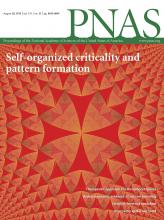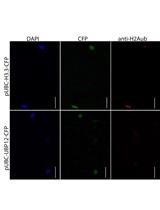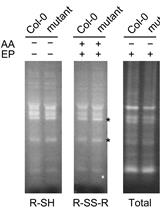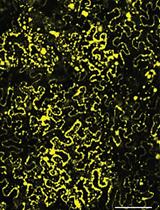- EN - English
- CN - 中文
Simple Method to Determine Protein Redox State in Arabidopsis thaliana
一种确定拟南芥蛋白氧化还原状态的简单方法
发布: 2019年06月05日第9卷第11期 DOI: 10.21769/BioProtoc.3250 浏览次数: 7357
评审: Jian ChenNoelia ForesiAnonymous reviewer(s)
Abstract
Thiol-based redox regulation is a posttranslational protein modification that plays a key role in many biological aspects. To understand its regulatory functions, we need a method to directly assess protein redox state in vivo. Here we present a simple procedure to determine protein redox state in a model plant Arabidopsis thaliana. Our method consists of three key steps: (i) redox fixation by rapidly freezing plant tissues in the liquid nitrogen, (ii) labeling of thiol groups with the maleimide reagent, and (iii) protein detection by Western blotting. The redox state of a specific or given protein can be discriminated by the mobility change on SDS-PAGE with high sensitivity. This method provides a novel strategy to dissect the working dynamics of the redox-regulatory system in plants.
Keywords: Protein (蛋白)Background
In living cells, proteins are subject to several posttranslational modifications. The dithiol/disulfide interconversion of a redox-active Cys pair, referred to as the redox regulation, is involved in a wide range of biological processes. In plant chloroplasts, this regulatory function seems to be strongly influenced by light conditions, because it is driven by a photosynthetically-generated reducing power (Buchanan, 1980). While the molecular machineries for supporting redox-regulatory system in chloroplasts, such as the thioredoxin (Trx), have been well identified so far (Buchanan et al., 2002; Lemaire et al., 2007; Jacquot, 2018), its working dynamics under environmental fluctuations remains poorly characterized. To address this issue, we need a methodology for analyzing the redox state of protein in vivo. To date, the spectrophotometric enzyme assay using a protein mixture extracted from intact chloroplasts or leaves has been often challenged on the assumption that the activation state of redox-regulated proteins is linked to their reduction level (Scheibe et al., 1989; Yoshida et al., 2007; Thormählen et al., 2015; Vaseghi et al., 2018). However, it is difficult from this assay to accurately estimate the redox state of the corresponding protein. Furthermore, we cannot exclude the possibility of nonspecific redox change during sample preparations and/or enzyme assays. To overcome these problems, an alternative approach to discriminate the redox state of proteins in a direct way is highly desirable. Here, we provide a simple protocol for determining protein redox state in a model plant Arabidopsis thaliana. This method has allowed us to uncover dynamic redox behaviors of several chloroplast proteins under varying light conditions (Yoshida et al., 2014, 2015 and 2018; Yoshida and Hisabori, 2016a and 2018), underpinning high sensitivity and accuracy of this strategy. This method is also applicable to proteins located in other cellular compartments (Yoshida and Hisabori, 2016b).
Materials and Reagents
- 1.5 ml microcentrifuge tube (WATSON, catalog number: 131-7155C)
- 10 μl pipette tip (WATSON, catalog number: 110-201C)
- 200 μl pipette tip (WATSON, catalog number: 110-705C)
- 1,000 μl pipette tip (WATSON, catalog number: 110-804C)
- 96-well EIA/RIA plate (Corning, catalog number: 3590)
- Absorbent paper (ATTO, catalog number: CB-09A)
- Immun-Blot PVDF membrane (Bio-Rad, catalog number: 1620177)
- Arabidopsis thaliana plants (Ecotype: Columbia-0)
- Liquid nitrogen
- Distilled water
- Tris(hydroxymethyl)aminomethane (Tris) (Nacalai Tesque, catalog number: 35434-21)
- Sodium lauryl sulfate (SDS) (Nacalai Tesque, catalog number: 31607-65)
- Glycerol (Nacalai Tesque, catalog number: 17018-83)
- Protease inhibitor cocktail tablet “cOmplete” (Roche, catalog number: 11836145001)
- Bromophenol Blue (BPB) (Wako, catalog number: 029-02912)
- 4-acetamido-4’-maleimidylstilbene-2,2’-disulfonate (AMS) (Invitrogen, catalog number: A485)
- Glycine (Nacalai Tesque, catalog number: 17141-95)
- Sodium chloride (NaCl) (Nacalai Tesque, catalog number: 31320-05)
- Polyoxyethylene (20) sorbitan monolaurate (Wako, catalog number: 167-11515)
- Methanol (Nacalai Tesque, catalog number: 21914-74)
- Pierce BCA protein assay kit (Thermo Scientific, catalog number: 23225)
- SDS-PAGE protein marker (e.g., Bio-Rad, catalog number: 161-0373)
- ECL Prime blocking agent (GE Healthcare, catalog number: RPN418V)
- ECL Prime Western blotting detection reagent (GE Healthcare, catalog number: RPN2232) or ECL Select Western blotting detection reagent (GE Healthcare, catalog number: RPN2235)
- Primary antibody for protein of interest
- Secondary antibody for protein of interest
- Immunoreaction enhancer (e.g., Can Get Signal, Toyobo, catalog number: NKB-101)
- Protein extraction/thiol labeling solution (see Recipes)
- Electrophoresis buffer for SDS-PAGE (see Recipes)
- Transfer buffer for Western blotting (see Recipes)
- TTBS (see Recipes)
Equipment
- Plant growth chamber (e.g., TOMY, model: CFH-415)
- 10 μl pipette (e.g., P10, Gilson, catalog number: F144802)
- 20 μl pipette (e.g., P20, Gilson, catalog number: F123600)
- 200 μl pipette (e.g., P200, Gilson, catalog number: F123601)
- 1,000 μl pipette (e.g., P1000, Gilson, catalog number: F123602)
- Mortar (AS ONE, catalog number: 5-4054-01)
- Pestle (AS ONE, catalog number: 5-4055-01)
- Refrigerated microcentrifuge (e.g., TOMY, model: MX-307)
- Heating blocks (e.g., TAITEC, model: CTU-Neo)
- Microplate reader iMark (Bio-Rad, catalog number: 1681130JA)
- Power supply (e.g., ATTO, model: AE-8135)
- Equipment for SDS-PAGE (e.g., NIHON EIDO, model: NA-1012)
- Equipment for Western blotting (e.g., BIO CRAFT, model: BE-320)
- Luminescence image analyzer (e.g., Fujifilm, model: LAS-4000 mini)
Software
- Software for image processing and analysis (e.g., ImageJ, http://imagej.nih.gov/ij//)
Procedure
文章信息
版权信息
© 2019 The Authors; exclusive licensee Bio-protocol LLC.
如何引用
Yoshida, K. and Hisabori, T. (2019). Simple Method to Determine Protein Redox State in Arabidopsis thaliana. Bio-protocol 9(11): e3250. DOI: 10.21769/BioProtoc.3250.
分类
植物科学 > 植物生物化学 > 蛋白质 > 修饰
生物化学 > 蛋白质 > 修饰
生物化学 > 其它化合物 > 硫醇
您对这篇实验方法有问题吗?
在此处发布您的问题,我们将邀请本文作者来回答。同时,我们会将您的问题发布到Bio-protocol Exchange,以便寻求社区成员的帮助。
Share
Bluesky
X
Copy link













